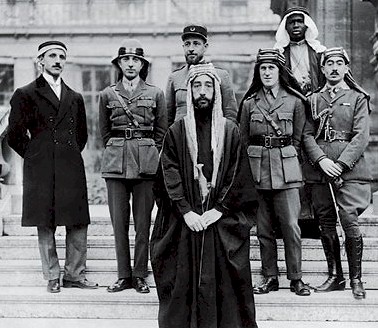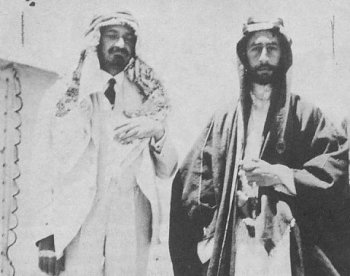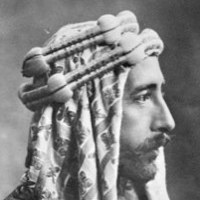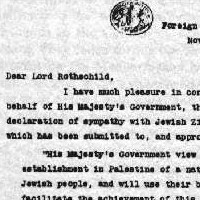Source: “Battleground: Fact and Fantasy in Palestine” by Samuel Katz (book)
by Joseph E. Katz; Agreement on Jewish Homeland
Feisal Hussein, King of Iraq and Syria agreed to Jewish National Home according to British Mandate (Israel and Jordan) in 1918. King of Iraq from 1921; eldest son of Hussein, sherif of Mecca. He led the Arab intifada against Turkey (1916-1918) and was designated king of Syria. Feisal was at first sympathetic to a Jewish Homeland from which he hoped to receive aid in building his future kingdom. He met Dr. Weizmann in Jordan (1918) and Paris (1919) where they reached an agreement on mutual aid, conditional on the implementation of British promises to the Arabs. Later, owing to his expulsion from Syria by the French (1920) and the influence of other Arab leaders, his attitude later became hostile.
By the mid-19th century, up to 100,000 people lived in Palestine, including a high percentage of Jews, whose forebears had lived there for thousands of years. In 1882, roughly 200,000 Muslims lived in all of Western Palestine.1 By 1918, the situation had not changed much: That was why Hussein ibn-Ali, Sherif of Mecca, and his son, King Faisal of Iraq, both endorsed and extolled the Balfour Declaration. 2
Hussein wrote in Mecca’s Al Qibla, in 1918, “The resources of the country are still virgin soil and will be developed by the Jewish immigrants. One of the most amazing things until recent times was that the Palestinian used to leave his country, wandering over the high seas in every direction. His native soil could not retain a hold on him…. At the same time, we have seen the Jews from foreign countries streaming to Palestine from Russia, Germany, Austria, Spain, and America. The cause of causes could not escape those who had a gift of deeper insight. They knew that the country was for its original sons [abna’ihi-l-asliyin], for all their differences, a sacred and beloved homeland. The return of these exiles (jaliya) to their homeland will prove materially and spiritually an experimental school for their brethren who are with them in the fields, factories, trades and all things connected to the land.” 3
In early 1919, King Faisal, then the only recognized Arab leader in the world, executed a treaty with Chaim Weizmann adopting the understanding of the Balfour Declaration. It outlined relations between Palestine and the Arab state, recognizing the former as a National Home for the Jews, in which they should quickly settle. He wrote, “We Arabs, especially the educated among us, look with the deepest sympathy on the Zionist movement. Our delegation here in Paris is fully acquainted with the proposals submitted yesterday to the Zionist organization to the Peace Conference, and we regard them as moderate and proper.” 4
The 1919 Faisal-Weizmann treaty provided a firm foundation for League of Nations ratification of the Balfour Declaration at the San Remo Conference in 1920. The proposals covered Palestine – from the Mediterranean through the entire Galilee, up to the Litany River, hundreds of miles east of the Jordan River through all of current day Jordan, and into part of the Sinai. The League assigned Palestine Mandate administration to Britain, entrusting it to establish the National Home for the Jews. 5
—
You can read the original agreement here: Agreement between Emir Faisal and Dr. Weizmann, januari 3, 1919. This agreement was never carried out as result of the changing in allied policy and Arab sentiment towards a Jewish Homeland.

Emir Faisal's party at Versailles, during the Paris Peace Conference of 1919. At the center, from left to right: Rustum Haidar, Nuri as-Said, Prince Faisal, Captain Pisani (behind Faisal) T.E. Lawrence, Faisal's slave (name unknown), Captain Tahsin Qadri.
Notes:
1. Katz, Battleground, pp. 90-115 (citing De Haas, Jacob, History of Palestine: The Last Two Thousand Years, New York: Macmillan, 1934), 123-127; Peters, Joan, From Time Immemorial, pp. 244-245, citing Dr. Carl Herman Voss, The Palestine Problem Today, Israel and Its Neighbors (Boston: Beacon Press, 1953), p. 13. Western Palestine (also then called Southern Syria) was considerably larger than the area that later became Israel. It is very misleading to cite their populations interchangeably, as Peters details.
2. Katz, Samuel, Battlegound: Fact and Fantasy in Palestine, 123-127.
3. Katz, Battleground, pp. 125-127.
4. Katz, Battleground, pp.125-127.
Mazzeltov,
Crethi Plethi



 RSS
RSS










[…] Agreement between Emir Faisal Husseini and Dr. Weizmann On 12.11.09, In Historical Documents, By Crethi Plethi The following agreement was made between Emir Faisal Husseini and Dr. Weizman on mutual aid in establishing a Jewish Homeland and a Greater Syria and Iraq, januari 3, 1919. This article is related to The spirit of Emir Faisal I and also to Joint Arab-Jewish Agreement on Jewish Homeland. […]
[…] want to read this article as well: Agreement between Emir Faisal and Dr. Weizmann and this article Joint Arab-Jewish Agreement on Jewish Homeland. […]
Joint Arab-Jewish Agreement on Jewish Homeland – http://t.co/uqG7inx6